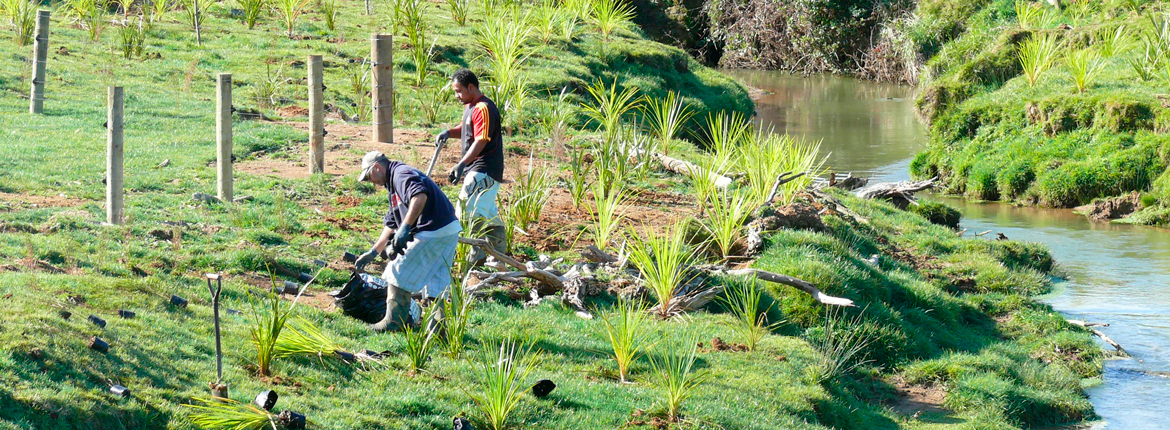
Planting the seed
Restoring farmland and waterways
Born and bred in Raglan, Fred Lichtwark was following in his farming forebears’ footsteps when a motorcycle accident changed everything. After a year in hospital, realising he had to rethink his career, he worked first as a deckhand on a commercial fishing boat, then as a river guide, rafting everywhere from the South Island to Papua New Guinea.
While these three careers have seemingly little in common, 25 years ago Fred saw the confluence and his new calling: conservation.
With his experience in farming, Fred could see the degradation of the land and waterways.
“During my lifetime I’ve watched Raglan’s rivers change. Some years ago, the fishery in our harbour was the worst in the country, surfers were complaining of ulcers forming when they got a scratch and farmers were getting all the blame. I realised that cleaning the rivers would clean up the harbour and that would improve our fisheries, our farms and also help tourism.”
Fred established a nursery with eco-sourced seeds and, while some considered him batty, he roused the community to support the project and Whaingaroa Harbourcare was born.
“Twenty-five years ago, it was a real battle. Not everybody embraces change, and some farmers were looking to string me up from the highest tree. They worried about costs. They didn’t think I had their interests at heart. But, being a local from a small rural area, everybody knew everybody and, even though people were suspicious of me telling them what to do, because people knew my grandparents and my dad, they gave me the time of day.”
The next step was to approach the District Council, whereupon Fred and his supporters proposed using a small farm as a model of what they could achieve on a wider scale. Consent was given, provided they worked with a committee of farmers, iwi representatives and a district councillor. If they all agreed to the plan, it could go ahead.
“We used the farm park on Wainui Reserve as our laboratory and retired one third of the unproductive land to plant trees. Within five years we had doubled production. The farmers on the committee saw first hand how we’d improved productivity and profit. As a result, they were the next landowners who adopted the riparian planting model on their properties and they, too, increased production dramatically. Then their neighbours, when they heard about increased revenue, also adopted the model. It’s been like dominoes.”
The multi-pronged approach includes fencing off waterways so stock don’t fall in and run off is reduced, and intensive riparian planting, which in turn creates employment opportunities. With 70% of farmers now invested in riparian planting, the landscape has changed dramatically, water quality has improved and bird numbers have been boosted with many farmers reporting what a joy it is to hear tūī, bellbirds and fantails. Many landowners have taken on responsibility for pest control as their personal projects, now they have lush corridors of native bush to protect.
“It’s fascinating which native trees are best suited to solve the problems faced by farmers. Take mānuka; everyone knows the benefits of mānuka honey and tea tree oil as a disinfectant but, as a tree in the ground, mānuka disinfect the soil and can even mitigate e-coli which can run off into riparian areas. When flowering, it’s also great for bees, which pollinate the clover in the paddocks, this then balances nitrogen which means farmers needn’t apply as much nitrogen on their paddocks which leads to more savings. It’s the perfect symbiotic relationship, so we plant a lot of mānuka.
“Cabbage trees are also incredible. They function like a human kidney with a root system that goes down as far as five metres to suck up all the nasties. Their big fibrous taproots grow in every direction and suck up heavy metals, including cadmium and the by-products of phosphate. It’s wonderful how nature provides all these amazing filtration plants to flourish around wetlands.”
Flax, hebes and koromiko all play their part, depending on where in the country planting is underway. Fred says that from Northland to Southland, there are plants specifically suited to each region to take on certain roles.
“These plants have been designed over millennia through self-managed genetic modification that make them resistant to local weather conditions: frost, salt, altitude, all sorts of things.”
Tōtara and various other podocarps are also being planted to accumulate carbon and, with sufficient width in their riparian strips, farmers can claim carbon credits.
“After doing this work for 25 years I’m still just as excited as I was on day one. The two millionth tree is sitting on weed mat at our nursery in Raglan and it will be planted later this year, along with 130,000 others. The change for the better in our catchment has been astonishing. It has also given us employment opportunities, better fishing, safer swimming and cleaner water for all living creatures.”
Reported by Elisabeth Easther for our AA Directions Autumn 2020 issue
